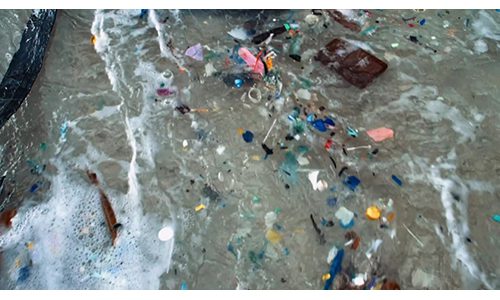Samsung points out that we have all seen the images of once beautiful beaches that are now covered in plastic waste. This problem the company explains is that birds, turtles and other forms of sea life are now required to share their habitats with endless mounds of bottles, straws and other discarded plastics.
The global manufacturer points out that so far, most of the efforts to clean up the ocean have focused on single use plastic products. But the plastics those plastics see are actually only the tip of the iceberg, according to Samsung. As a result of these issues Samsung stresses the development of eco-conscious products and solutions more important than ever.
Scientists estimate that the ocean floor alone is now home to over 14 million tons of what are called “microplastics.” These tiny pieces of plastic are often too small to see with the naked eye, but can also measure up to 5mm in size. These microplastics can have devastating effects on ecosystems and even human health. Around the world, more than 80 percent of tap water samples contain traces of microplastics. One study from the World Wildlife Fund estimates that humans ingest the equivalent of one credit card of plastic per week3 through the air they breathe and the water they drink.
Microplastics can enter the environment in a few different ways. The first is when they’re released directly as small plastic particles, such as microbeads. These substances are known as primary microplastics. The second way is when larger plastics from everyday items break down over time into tiny pieces. These types are known as secondary microplastics.
Another form of microplastic that many people aren’t aware of is the kind that is released from laundry when people wash synthetic textiles. From manufacturing these fabrics to washing them, microplastics can be created throughout many stages of these products’ lifecycles.
NGOs, governments and brands around the world have taken note of the rising number of microplastics and are taking important actions to help keep them out of the oceans. Add-on filters for washing machines and protective laundry bags are just some of the solutions that are now available to help capture some of the microplastics released during washing.
Add-on filters and laundry bags are a start, Samsung continues, but it states that more holistic solutions are needed to cut down the amount of microplastics that are released throughout a product’s lifecycle. That’s why Samsung is working with Patagonia on a joint solution.
Together, the companies are working on a feasible, effective and expandable way to combat the microplastics that result from textiles and laundry. Samsung is taking the goal of cleaner oceans to heart by designing a sophisticated new washing machine that lets people safely wash their favorite garments while minimizing the impact of microplastics. And this eco-conscious solution will come without compromising on the high-performance cleaning and care that Samsung’s washers are known for.
This is only the latest in a long line of steps Samsung is taking to create long-lasting appliances that improve environmental sustainability. Samsung’s washers already use a unique feature called Ecobubble, which lets consumers clean their clothes efficiently, even at low temperatures, by generating a greater amount of bubbles. This helps the detergent quickly penetrate fabrics and remove dirt, all while saving energy and protecting the color and texture of the clothing.
More news from Samsung: Samsung Joins Home Connectivity Alliance (HCA)







